Some ideas regarding soil testing and the test report
When people receive the soil test report, many get confused by the recommendations written in it. They think that is the final word. But in reality, it is far from the final word and doesn’t even fall into that category. The report is merely information. Based on that information, a geotechnical engineer will decide what the foundation should be…”
What is a Soil Test?
The Bengali meaning of ‘Soil Test’ is ‘mate parkas’ (soil examination), but in engineering terms, the process of testing the soil beneath a structure or building is called a soil test or sub-soil investigation.” A soil test, is a process through which the composition, characteristics, and quality of the soil are verified. Various information is collected through this test.
Site Inspection
Before conducting a soil test, it is important to perform a site inspection. This will provide a comprehensive understanding of the surface condition of the soil and help determine how the soil test should be carried out. The following information should be collected during the site visit:
- Geographical condition of the area
- Presence of any pits or holes
- Whether the soil has been excavated or removed
- Signs of land subsidence
- Water levels in nearby areas (such as rivers or ponds)
- Drainage system, etc.”

Purpose of Soil Testing:
The main purpose of soil testing is to collect accurate information about the nature and characteristics of the soil so that the design and construction of structures can be done properly. Through this, the following can be determined:
- The bearing capacity of the soil.
- The stratification of the soil layers.
- The density and moisture content of the soil.
- The shear strength of the soil.
- The compressibility of the soil.
- The permeability of the soil.
Using this information, engineers can design appropriate foundations and ensure the safety of any future structures.”
What is a Soil Test Report?
Understand the soil condition by looking at the N value in the soil test report:
- If the value is 2 or less, it indicates very soft soil, with a bearing capacity of only 2 tons per square meter.
- If the value is between 2-5, it indicates soft soil, with a bearing capacity of 2-5 tons per square meter.
- If the value is between 5-9, it indicates medium soil, with a bearing capacity of 5-10 tons per square meter.
- If the value is between 9-17, it indicates stiff or hard soil, with a bearing capacity of 10-20 tons per square meter.
- If the value is between 17-33, it indicates very stiff soil, with a bearing capacity of 20-40 tons per square meter.
- If the value is above 33, it indicates hard soil, with a bearing capacity of over 40 tons per square meter.”
How Many Boreholes Are Needed for a Given Land Area
The number of boreholes is determined based on the size of the land and the type of project. Generally, the following guidelines are followed:
- For land up to 3 kathas, 3 boreholes are required.
- For 3 to 5 kathas, 5 boreholes are required.
- For 5 to 10 kathas, 8 boreholes are applicable.
The main objective of determining the number of boreholes is to get a comprehensive understanding of the soil condition across the entire land, so that proper design and construction can be carried out.
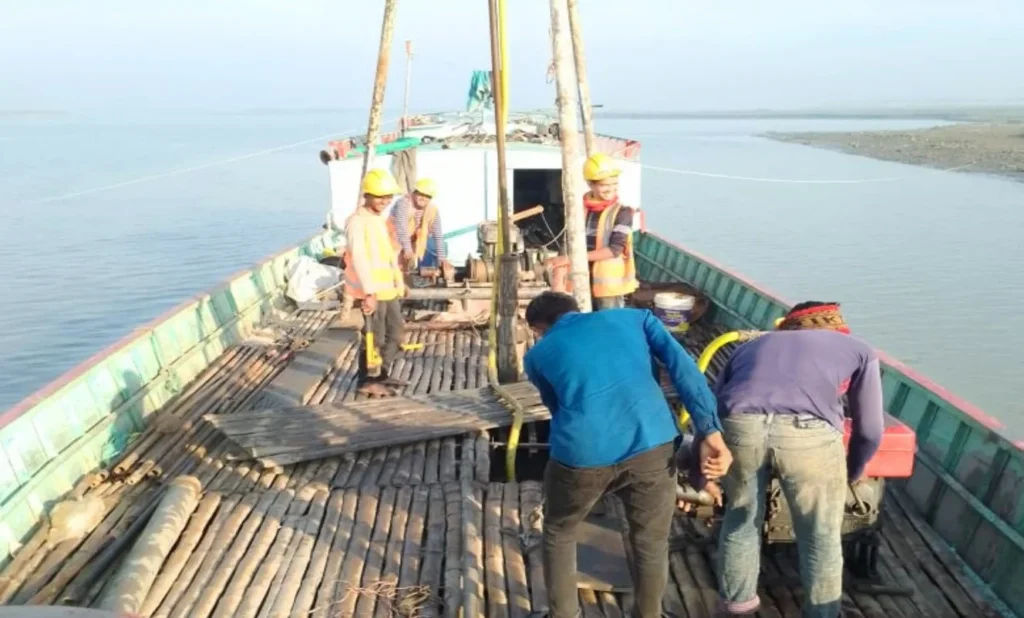
The Necessity of Conducting Soil Tests
Soil tests are conducted to determine the safe bearing capacity of subsurface soil. It is important to remember that soil testing is essential for the design of any type of structure, such as residential buildings, commercial buildings, schools, colleges, mosques, temples, hospitals, shopping complexes, bridges, culverts, roads, highways, railways, airports, power plants, etc. Soil testing is a critical step that helps ensure the safety and durability of construction projects. The necessity of soil testing arises for the following reasons:
- Determining Soil Bearing Capacity: Soil testing reveals how much load the soil can support. The foundation is designed based on this information.
- Selecting the Type of Foundation: The type of foundation is determined according to the nature of the soil. Accurate foundation design is not possible without soil testing.
- Analyzing Soil Layers: Soil testing provides information about the characteristics of different soil layers, which aids in enhancing the durability of the construction and strengthening the foundation of the structure.
- Assessing Landslide Risks: Some areas are prone to landslides. Soil testing helps identify these risks, which play a crucial role in the project’s design.
- Water Drainage System: The permeability of the soil is determined, which helps in planning the drainage system for the construction area.
- Controlling Construction Costs: Proper soil testing helps control costs in foundation design and construction processes, as it aids in avoiding unnecessary expenses.
Starting any construction work without soil testing can lead to future disasters, such as cracks, subsidence, or collapse, negatively affecting the safety and durability of the construction. It’s like taking medication without a doctor’s prescription; without a soil test, it’s impossible to understand the properties of subsurface soil. Only by reviewing a soil test report can an engineer determine what type of foundation is necessary to ensure the safety of the structure. However, in our country, engineers often do not recommend soil testing for light structures (one- or two-story buildings) because the safe bearing capacity of soil is generally around 9-10 tons per square meter. These light buildings do not impose a load greater than this. Nevertheless, soil testing is essential for structures with more than three floors.

Importance of Soil Test for Residential Building:
Soil testing is done before construction begins, especially before designing, as it is an essential prerequisite for foundation design. The main purpose of this test is to determine the soil’s bearing capacity. Additionally, soil testing helps in determining the type of foundation, whether it should be shallow (like footing) or deep (like piling). The bearing capacity and foundation type are mentioned in the soil test report. Based on the report, the foundation design is made. The report also includes details such as SPT (Standard Penetration Test), soil type, stratification, test results, and boring point layout.
Without a soil test, it is impossible to design a proper foundation. If the foundation is not correctly designed, the structure may settle unevenly or develop cracks, which can cause significant damage or even lead to structural failure. In areas with weak soil, soil testing is required to ensure that piling is properly designed to resist the effects of earthquakes.
The importance of soil testing for residential building construction is crucial for several reasons. The soil’s properties, stability, and the foundation’s load-bearing capacity are determined through the soil test, which ensures the safety and long-term durability of the building. The key reasons and benefits of soil testing are as follows:
1. Determining Soil Bearing Capacity:
Through soil testing, it is possible to assess how much weight or pressure the soil can bear. Without knowing this accurately, designing a proper foundation is not possible. Incorrect design can reduce the building’s stability and increase the likelihood of future damage.
2. Foundation Design:
The design of the foundation for a residential building is determined based on the soil’s characteristics. If the foundation is chosen without a soil test, the building may settle unevenly or develop cracks, posing significant risks to the structure.
3. Analysis of Soil Type and Layers: Soil testing helps analyze different soil layers and their properties. If the soil is soft or overly moist, additional measures need to be taken to strengthen the foundation. Without this information, the building may be at risk of collapse in the future.
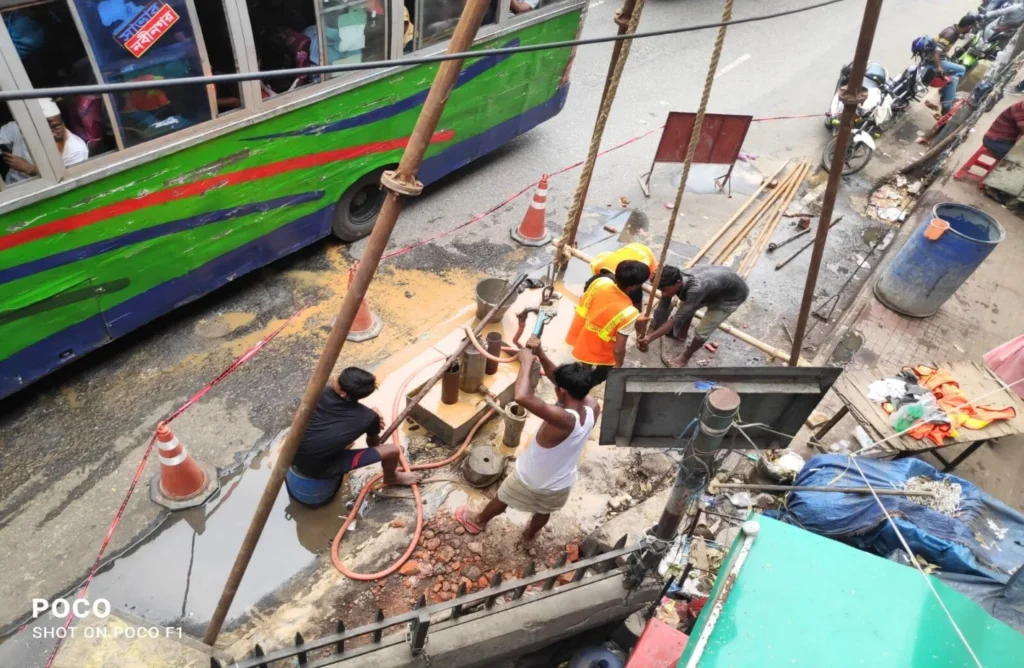
Impact of Groundwater Levels:
Soil testing assesses the position of the groundwater table, its height, and its effects. If this is not known, water accumulation in the foundation can cause damage, reducing the building’s durability.
5. Foundation Type Selection:
Soil testing helps determine whether a shallow or deep foundation is appropriate for the building. If the foundation is not selected based on the soil’s characteristics and local climate, the building may suffer damage.
6. Controlling Construction Costs:
Proper soil testing helps avoid excessive construction costs. A foundation design based on accurate soil testing ensures cost control and minimizes the risk of unforeseen expenses in the future.
7. Safety and Durability:
Without soil testing, starting construction could lead to cracks, uneven settlement, or collapse, which negatively affects the building’s safety and durability.
Summary:
Soil testing is essential before constructing a residential building, as it ensures the building’s long-term stability and safety.
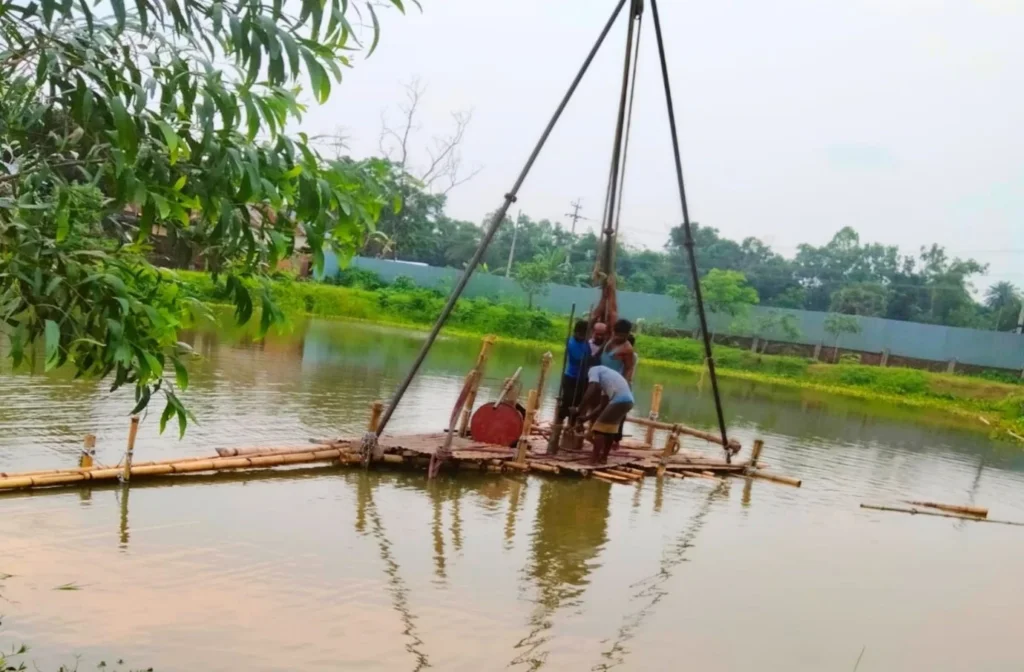
How is a Soil Test Conducted?
In our country, soil investigations are typically carried out using the wash boring method. In this method, a 2-inch diameter pipe is driven into the ground by hammering, with the help of water. Every 5 feet or 1.5 meters, soil samples are collected, and the number of blows is counted.
For every 5 feet, during the next 1.5 feet (or 18 inches) of pipe insertion into the ground, the value of N (blow count) is recorded. However, the blow count for the first 6 inches is not considered.
In other words, the number of blows required to drive the next 12 inches is the value of N. For instance, if it takes 15 blows to penetrate the 12 inches, then the N value is 15. The N value varies across different soil layers. For example, in the first 10-15 feet, the N value is usually very low.
If the N value exceeds 15, it indicates a strong soil layer.
Procedure for Soil Testing:
Soil testing is done using various methods to gather accurate information about the nature and properties of the soil. The following steps are typically followed for soil testing:
- Site Inspection:
Before starting the soil test, a site inspection is conducted. This helps in understanding the preliminary condition of the soil and the geographical characteristics of the site. - Borehole Drilling:
Boreholes are drilled at specific locations on the site. Typically, boreholes are drilled to a depth of 5 to 30 meters, though the depth may vary depending on the project. Soil samples are collected through these boreholes. - Soil Sample Collection:
After drilling the borehole, soil samples are collected from different depths. These soil samples are then sent to the laboratory for analysis. - Laboratory Testing:
In the laboratory, various characteristics of the soil are analyzed. Some common tests include:
- Atterberg Limits Test: To determine the soil’s consistency based on its plasticity and moisture content.
- Sieve Analysis: To determine the size and distribution of soil particles.
- Moisture Content Test: To measure the amount of moisture in the soil.
- Specific Gravity Test: To determine the density of the soil.
- Compaction Test: To evaluate how much the soil can be compacted and how much load it can bear.
- Shear Strength Test: To measure the soil’s resistance to shearing or sliding forces.
- Field Tests:
Some tests are also conducted in the field, such as:
- Standard Penetration Test (SPT): A special tool is used in the borehole to determine the soil’s resistance capacity.
- Cone Penetration Test (CPT): A cone is pushed into the soil to assess its strength and load-bearing capacity.
- Report Generation:
After all tests are completed, a report is generated by the laboratory. This report includes detailed information about the soil’s strength, layers, moisture, and bearing capacity. Engineers use this information to design the foundation of the building.
Information Obtained from Soil Testing:
- Bearing Capacity of Soil:
Soil testing helps determine the soil’s load-bearing capacity, which reveals how much pressure or load the soil can support. This is crucial for designing the foundation. - Soil Stratification:
Soil testing identifies the characteristics and properties of different soil layers. It helps in understanding the location of various soil layers and how deep the strong or weak layers are. - Density and Moisture Content of Soil:
The test measures the soil’s density and moisture content. Based on the density, the stability of the foundation is determined, and moisture content affects the soil’s strength and compressibility. - Shear Strength of Soil:
Soil testing determines the soil’s shear resistance or its ability to resist sliding, which is a key indicator of soil stability. - Soil Compressibility:
The compressibility of the soil is measured to assess how much the soil will compress under pressure. This information is vital for the building’s stability. - Soil Permeability:
The test measures the rate at which water flows through the soil. It indicates how quickly or slowly the soil absorbs or drains water, which is important for building basements or other water-sensitive structures.
These details are critical for engineers because they provide the necessary data to design and construct the foundation of a building correctly. Without soil testing, the safety and stability of a structure cannot be guaranteed. This information is essential to ensure the security and durability of construction projects.
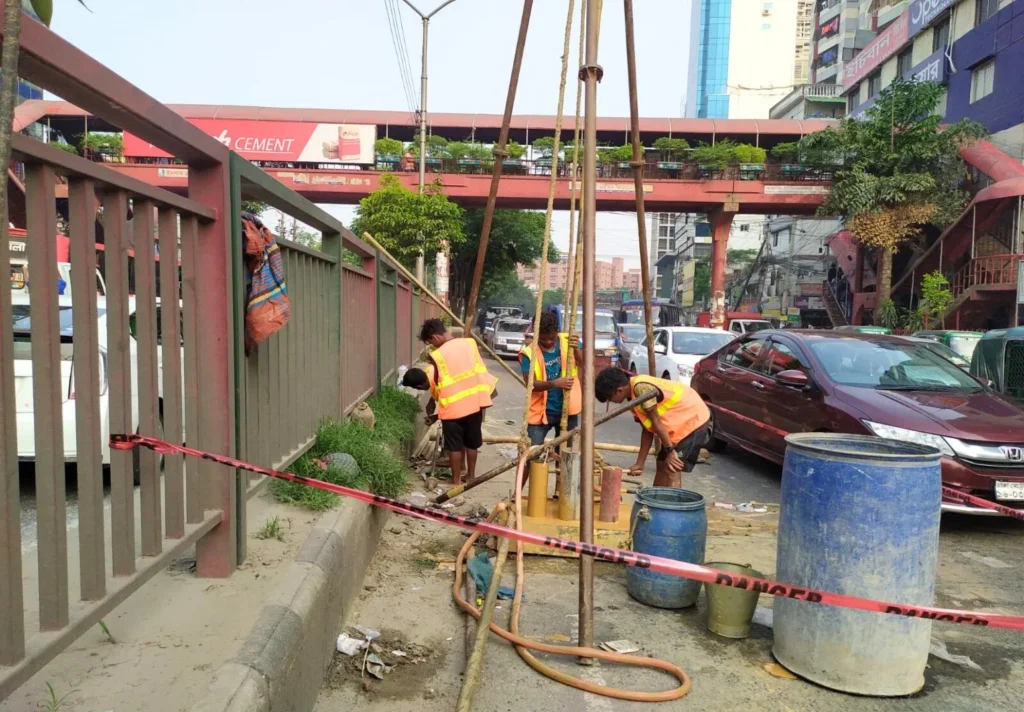
Precautions During Soil Testing:
- Ensure that the hammer weighs exactly 63.5 kg and that it is being dropped from a height of 30 inches.
- Check whether soil samples are being collected and stored in separate packets for every 5 feet of drilling.
- Verify that the N-value is being accurately counted and properly recorded.
- Even if the soil quality is good, it is advisable to collect samples up to at least 60 feet.
Methods of On-site Soil Testing:
- Inspect and survey the site or plot.
- Determine the number and location of boreholes based on field conditions, and complete the boring work accordingly.
- Set the boring depth as per the project requirements.
- Collect both undisturbed and disturbed soil samples from each borehole location and send them to the laboratory for testing.
- Use boring or drilling techniques to determine the SPT (Standard Penetration Test) value at 5-foot intervals, and calculate the soil’s safe bearing capacity.
- Analyze the results from both field and laboratory tests.
- Finally, prepare a comprehensive soil test report and provide recommendations for the building’s foundation based on the findings.
There are generally two types of soil testing:
- Field Test of Soil
- Laboratory Test of Soil
Field Test of Soil
Field testing of soil refers to the process of examining the characteristics, properties, and conditions of the soil directly at the site. These tests are carried out based on the real conditions of the soil and provide essential information for construction projects.
Main types of field tests for soil:
- Standard Penetration Test (SPT): In this test, a standard hammer is used to take a soil sample through a borehole at a specific depth. A 30-pound weight is dropped on the hammer every 30 cm, and the number of blows required to collect the sample is recorded.
- Cone Penetration Test (CPT): In this test, a cone-shaped penetrator is inserted into the soil to assess its strength and load-bearing capacity.
- Field Vane Shear Test (FVST): A vane is used in this test to determine the shear strength of the soil, usually applied for soft or loose soils.
- Plate Load Test: A plate is placed on the soil, and a load is gradually applied to it. This test helps determine the soil’s bearing capacity and compression ability.
- Water Table Observation: This test identifies the height of the local water table, which is crucial for designing the drainage system and foundation of the construction project.
Importance of Field Tests:
Field testing of soil provides engineers with initial information about the soil’s characteristics and conditions, which are crucial for designing the foundation and construction of the building. The information obtained from these tests ensures that the project is correctly planned and implemented.
The results from field tests are often compared with laboratory test results to give engineers a complete picture. Information gained from field tests helps ensure the safety and durability of future construction projects.
Specific Field Tests:
a. Plate Load Bearing Test: This is a common instrument-based method used to measure the final bearing capacity of the soil at any layer and to determine soil compression. The results obtained from this test can be compared and verified for accuracy.
b. Standard Penetration Test (SPT): The SPT helps determine the “N” value of the soil. Soil samples collected during the test are sent to the laboratory for analysis. In the field, the “N” value is measured every 5 feet of boring, providing direct guidance on the soil’s bearing capacity. Using the “N” value, the bearing capacity of the soil can be directly tested in the field.
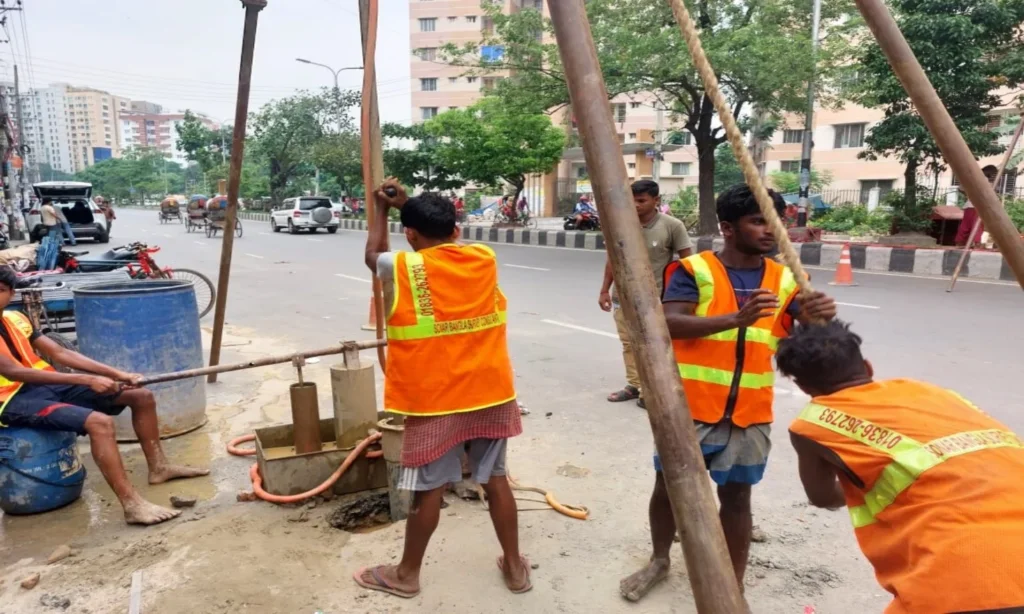
Soil Laboratory Test:
According to ASTM standards, soil laboratory tests typically include the following:
- Moisture Content Test
b) Plasticity Test
c) Specific Gravity Test
d) Density Test
e) Consolidation Test
f) Direct Shear Test, etc.
Purpose of Soil Testing:
Soil testing is a highly important process that is used to gather and determine essential information for land and construction projects. Understanding the benefits of soil testing is key, and some examples are provided below:
- Land Mapping: Soil testing helps in creating detailed land maps. It provides highly specific information about the site’s soil, which is crucial for intelligent planning and design processes.
- Soil Verbal Analysis: Soil testing aids in verbal analysis of the site’s soil, offering insights into land access, projections, and slope development for the site.
- Natural Characteristics of the Land and Nearby Projects: Soil testing assists in determining the natural phases, soil properties, and climate around the project, which is essential for building bridges or other structures.
- Problem Resolution for Road and Railway Projects: Soil testing helps solve issues related to the construction of bridges or railway tracks, ensuring stability and safety.
- Budget Planning for Projects: Soil testing provides critical data for planning the project’s budget, helping to estimate the construction volume and timeline effectively.
- What tests are typically found in a soil testing set and how are they conducted?
A soil testing set typically includes a variety of tests designed to determine the characteristics and capacity of the soil. Through these tests, the soil’s type, structure, stability, and load-bearing capacity are assessed. Below are the common tests found in a complete soil testing set and how they are conducted:
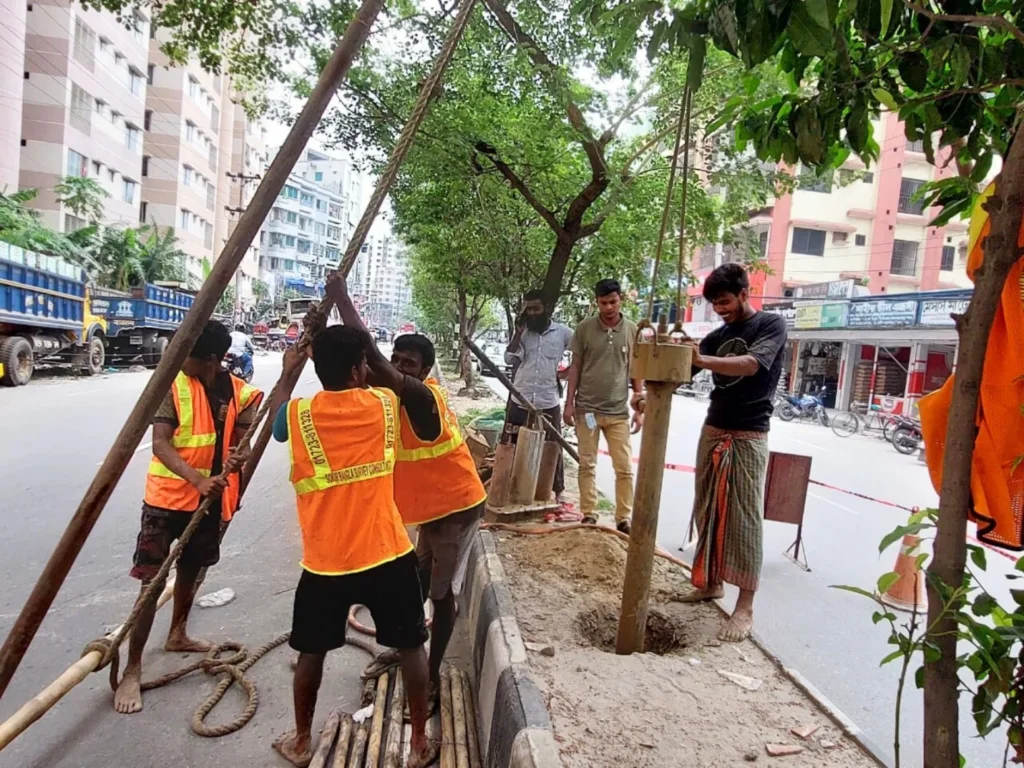
01. Moisture Content Test
- Purpose: To determine the amount of moisture or water content in the soil.
- Method: A sample of soil is weighed, then dried in an oven and reweighed. The difference between the weights before and after drying gives the moisture content.
2. Plasticity Test
- Purpose: To measure the plasticity and changeability of the soil.
- Method: The Atterberg Limits Test is performed, which determines the soil’s liquid limit, plastic limit, and shrinkage limit.
3. Standard Penetration Test (SPT)
- Purpose: To measure the soil’s strength and load-bearing capacity.
- Method: A sample is collected through a borehole using a hammer, and the number of blows (N-value) required to drive the sample is recorded.
4. Consolidation Test
- Purpose: To measure the soil’s compressibility and evaluate building stability.
- Method: A specific weight is applied to the soil, and the amount of compression is measured.
5. Direct Shear Test
- Purpose: To determine the shear strength or cutting resistance of the soil.
- Method: A horizontal force is gradually applied to a soil sample, and the shear strength is measured.
6. Specific Gravity Test
- Purpose: To determine the specific gravity of the soil.
- Method: A pycnometer is usually used to measure soil density, which helps determine the soil’s specific gravity.
7. Proctor Compaction Test
- Purpose: To determine the maximum density and moisture content required for soil compaction in construction.
- Method: The soil sample is compacted at various moisture levels to determine its density.
8. Plate Load Test
- Purpose: To measure the soil’s load-bearing capacity.
- Method: A plate is placed on the soil, and continuous load is applied to determine the soil’s compression and bearing capacity.
9. Cone Penetration Test (CPT)
- Purpose: To measure the soil’s strength and load-bearing capacity.
- Method: A cone-shaped instrument is driven into the ground to measure the soil’s resistance.
10. Field Vane Shear Test
- Purpose: To measure the shear strength of soft soil.
- Method: A vane is inserted into the soil, and its resistance to rotation is measured.
In addition to these, other specific tests may include soil pH testing and electrical resistivity tests.

Each test determines various soil properties and helps engineers make informed decisions, particularly in foundation design and other construction activities.
Typically, there are specialized companies that perform soil testing. In some cases, land surveying companies can conduct these tests if they are licensed to do so. You can ask the architect or engineer involved in designing your land for recommendations on skilled companies for this service. In Bangladesh, the most commonly used method for soil testing is called the “wash boring” method. The process generally involves the following steps:
A two-inch diameter pipe is pushed into the soil using water pressure. Every five feet (or approximately 1.5 meters), a blow count is recorded, and a soil sample is collected. The number of blows required to insert the next 1.5 feet of pipe into the soil is generally not considered. The number of blows required to push the next 12 inches of pipe into the soil is referred to as the N-value.
- Typically, the N-value is less than 15, but if it exceeds 15, the soil is considered to be strong. The bearing capacity of the soil is determined based on the N-value.
Sonar Bangla Survey Consultants have their own soil testing lab. Please contact us for more information.
Make sure the soil tester or surveyor is considering certain key aspects during soil testing. Below are a few points to verify:
• The weight of the hammer used for pressure application must be 63.5 kg. • It should be dropped from a height of at least 30 inches while applying force. • Separate soil samples should be collected every 5 feet and stored in individual packets. • The N-value for each instance must be recorded separately. • Even if the soil quality is good, samples should be collected from a depth of at least 60 feet.
It’s essential to ensure that certain aspects are being considered by the soil tester or surveyor. Pay attention to the following:
- Proper Sample Collection: Ensure that the soil samples are being collected accurately from the correct depth to guarantee valid test results.
- Accurate N-Value Calculation: Verify that the N-value, which reflects the soil’s load-bearing capacity, is being correctly calculated for each layer.
- Quality Testing Methods: Check whether the tests follow ASTM or other internationally recognized testing standards.
- Detailed Documentation: Ensure that the results for each test, such as blow count, soil elasticity, moisture, etc., are properly documented.
- Proper Calibration of Equipment: Confirm that the testing equipment is accurately calibrated and functioning correctly.
- Water Table Observation: Make sure the ground water level is being observed accurately, as it can influence foundation design and soil stability.
- Soil Type Identification: Verify whether the soil type and its characteristics, such as plasticity, density, and moisture, are being correctly identified.
- Safety Measures: Ensure that proper safety protocols are being followed during soil excavation and sample collection, especially for deep boreholes.
By paying attention to these factors, the soil testing process can be more reliable, ensuring the stability and safety of the building foundation.
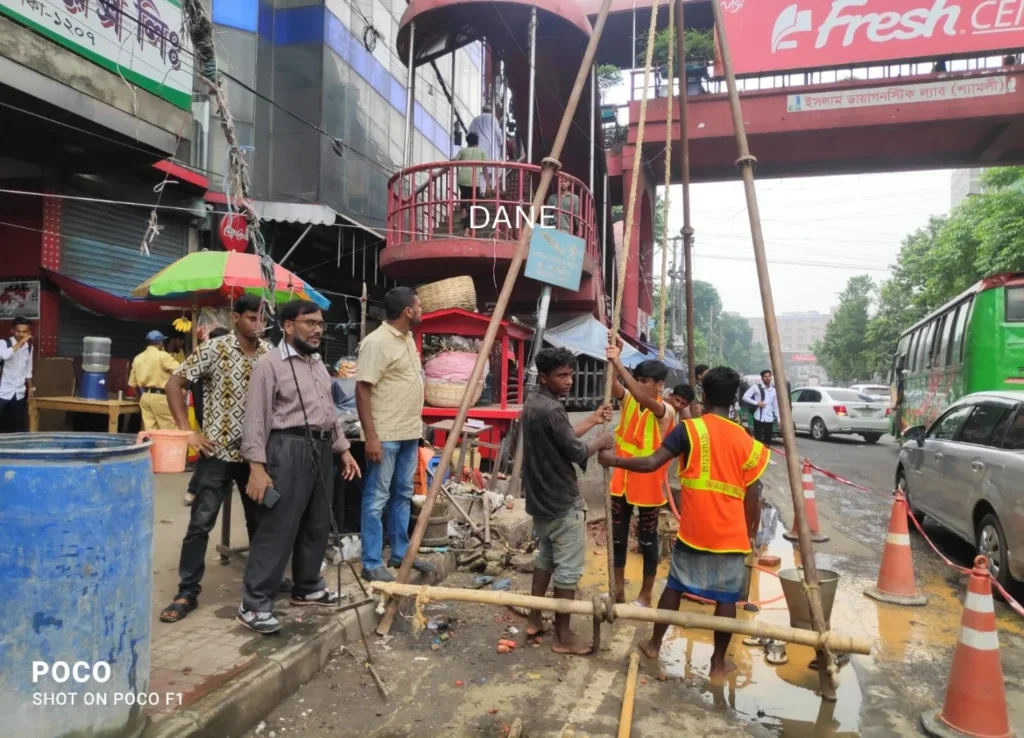
What precautions should be taken during a soil test?
- Ensure that the hammer weighs 63.5 kg and is being dropped from a height of 30 inches.
- Check if separate soil samples are being stored in individual packets every 5 feet.
- Verify that the N value is being counted and recorded accurately.
- Even if the soil appears to be good, it is advisable to collect samples from a depth of at least 60 feet.
The Importance of Soil Testing for Piling
In our country, the safe load-bearing capacity of the soil is typically around 9-10 tons per square meter. As a result, engineers generally do not recommend soil tests for light structures, such as one- or two-story buildings, since these lighter buildings do not impose loads exceeding this limit. However, for buildings with three or more stories, a soil test is essential.
Without a soil test, you cannot determine how many piles are needed for a building. It is impossible to ascertain how deep the piles should be or how many feet of diameter are required without a soil test. The type of piling you intend to use and which piles would be suitable for your building can be understood through soil testing. The soil test will also indicate how many stories you can safely construct. Remember, designing without a soil test is akin to taking medication without a doctor’s prescription. Additionally, it is impossible for anyone to understand the characteristics of subsurface soil without a soil test. Only by examining the soil test report can an engineer determine the type of foundation necessary for structural safety.
A pile is a type of deep foundation through which the load of a structure is transferred. Piling is used when the load-bearing capacity of the soil is very low. Through piles, the load of the structure is distributed. Decisions regarding whether the foundation should be deep or shallow are made based on the soil test report. The design of the piling is also based on the results of the soil test.
Who Should Conduct the Soil Test
You should have the soil test conducted by those who have their own laboratory and experienced soil engineers.
Conclusion
As you stand atop a hill, gazing out at the undulating landscape, you’re reminded of the ancient Greek myth of Daedalus, who mastered the art of traversing complex labyrinths.
Similarly, a Soil Test is your map, guiding you through the twists and turns of the terrain.
With its precise measurements and intricate lines, it’s your key to deciphering the secrets of the land, ensuring your construction projects are built on solid ground.
For a professional and accurate contour survey, call Sonar Bangla Survey Consultants office at +880 1742 585592 to get a free quotation from a team with a proven track record of excellence, boasting over 150 5-star reviews on Google.

